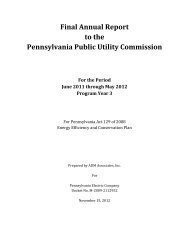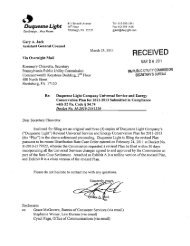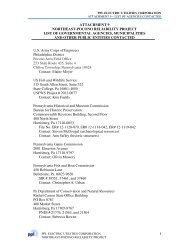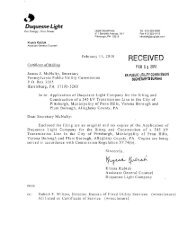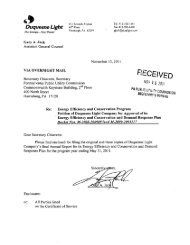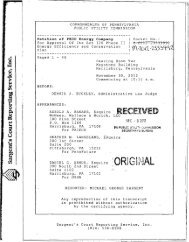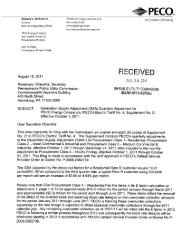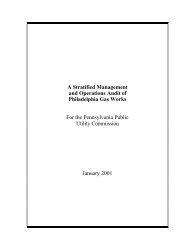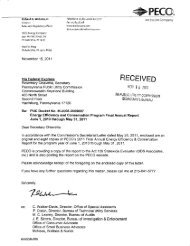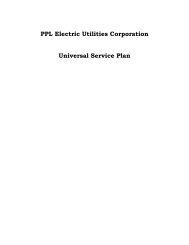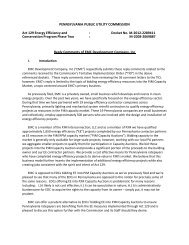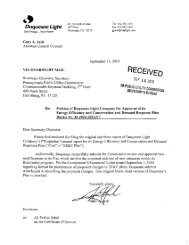Reliability Report -- 1999 - Pennsylvania Public Utility Commission
Reliability Report -- 1999 - Pennsylvania Public Utility Commission
Reliability Report -- 1999 - Pennsylvania Public Utility Commission
You also want an ePaper? Increase the reach of your titles
YUMPU automatically turns print PDFs into web optimized ePapers that Google loves.
Metropolitan Edison Company<br />
In 2010, Met-Ed experienced 823,797 customer interruptions with a total duration of 98.7 million<br />
customer minutes, or 35.2 percent higher than 2009. One major event occurred in Met-Ed’s service<br />
territory during 2010. The calculation of the reliability indices excludes outage data relating to this<br />
event, which was approved by the <strong>Commission</strong>. 27<br />
• July 7, 2010 – A broken crossarm on a 115-kV transmission line caused a fault, eventually<br />
leading to rotating outages as a result of a 225-MW load interruption and line constraints; 81,253<br />
customers were affected (15 percent).<br />
Met-Ed’s CAIDI for 2010 was 120 minutes, an increase from 111 minutes in 2009, and three minutes<br />
above the benchmark, and better than the standard by 14.3 percent. CAIDI had been below the<br />
benchmark for every quarter from December 2007 to March 2010. The CAIDI three-year average was<br />
17 minutes below the standard of 129 minutes. For the 12-month average ending March 31, 2011,<br />
CAIDI was 111 minutes, or 5.1 percent below the benchmark. SAIDI increased from 134 minutes in<br />
2009 to 181 minutes in 2010, which is 6.7 percent better than the standard. Figure 11 shows the trend in<br />
the duration of customer interruptions for the Met-Ed system from March 2004 through March 2010,<br />
compared to the established benchmark and standard for CAIDI.<br />
Met-Ed’s SAIFI increased from 1.21 in 2009 interruptions per customer to 1.51 in 2010, a 24.8 percent<br />
decline and 9.4 percent above the standard. SAIFI had been trending downward until the quarter ending<br />
September 2010. Met-Ed attributes this to several non-excludable storm events. For the three-year<br />
average SAIFI performance, Met-Ed was above the SAIFI three-year standard by 6.8 percent. For the<br />
12-month average ending March 31, 2011, SAIFI was 1.46, or 5.8 percent above the standard. Figure<br />
12 shows the trend in the frequency of customer interruptions for the Met-Ed system from March 2004<br />
through March 2011, compared to the established benchmark and standard for SAIFI.<br />
In 2010, equipment failure was responsible for 24.1 percent of incidents, 28.3 percent of customers<br />
affected and 19.7 percent of interruption minutes. Non-preventable tree-related incidents caused 21.6<br />
percent of the incidents, 26.1 percent of customers affected and 41.8 percent of interruption minutes.<br />
Animals caused 4.0 percent of the outages, 4.0 percent of customers affected and 3.0 percent of<br />
interruption minutes. Of the total number of incidents, 12.5 percent were assigned to Met-Ed’s<br />
“unknown” category. This category ranked as the No. 4 cause for outages. Figure 13 shows the<br />
distribution of causes of service outages occurring during 2010 as a percentage of total outages. The<br />
trend in the number of outages by the top four major causes is shown in Figure 14.<br />
In 2010, Met-Ed implemented a series of reliability improvement initiatives to “storm proof” or<br />
“harden” the three-phase distribution backbone, including aggressive tree-trimming and detailed circuitcondition<br />
assessments. To limit the scope of an outage, additional protective equipment, such as fuses,<br />
reclosers and remote-controlled switches were systematically added.<br />
27 Docket No. M-2010-2200103.<br />
Electric Service <strong>Reliability</strong> in <strong>Pennsylvania</strong> 2010 17




